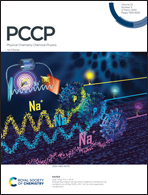Rational design of non-fullerene acceptors via side-chain and terminal group engineering: a computational study†
Abstract
We investigated the optoelectronic and photovoltaic properties of three types of acceptor–donor–acceptor-based non-fullerene acceptor (NFA) molecules for organic solar cell (OSC) applications. Density functional theory and its time-dependent variant were employed to compute the quadrupole moment perpendicular to the π-system (Q20), open circuit voltage (VOC), and other relevant solar cell parameters. The role of functionalization in the acceptor unit on the overall device performance was explored by incorporating halogen and methoxy-based electron-withdrawing groups. The electronegativity differences between the halogen atoms and the methoxy group demonstrated contrasting effects on the energy levels, molecular orbitals, and absorption maximum. We observed a trade-off between short-circuit current (JSC) and VOC, which was further substantiated by an inverse correlation between Q20 and VOC. We found an optimum value of Q20 in the range of 80 to 130 ea02 to achieve an optimized solar cell performance. Among the designed systems, Se-derived NFAs with a small band gap, red-shifted absorption maximum, high-oscillator strength, small exciton binding energy, and optimum Q20 turned out to be potential candidates for future applications. These criteria can be generalized to design and screen next-generation non-fullerene acceptors to achieve improved OSC performance.



 Please wait while we load your content...
Please wait while we load your content...